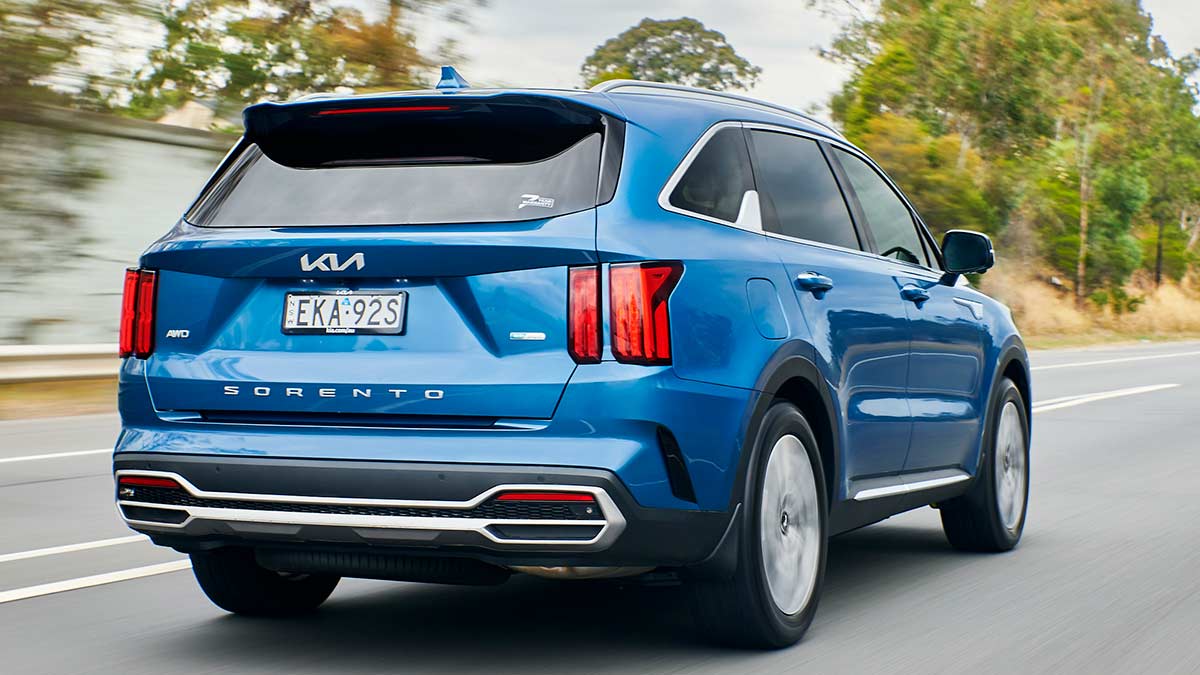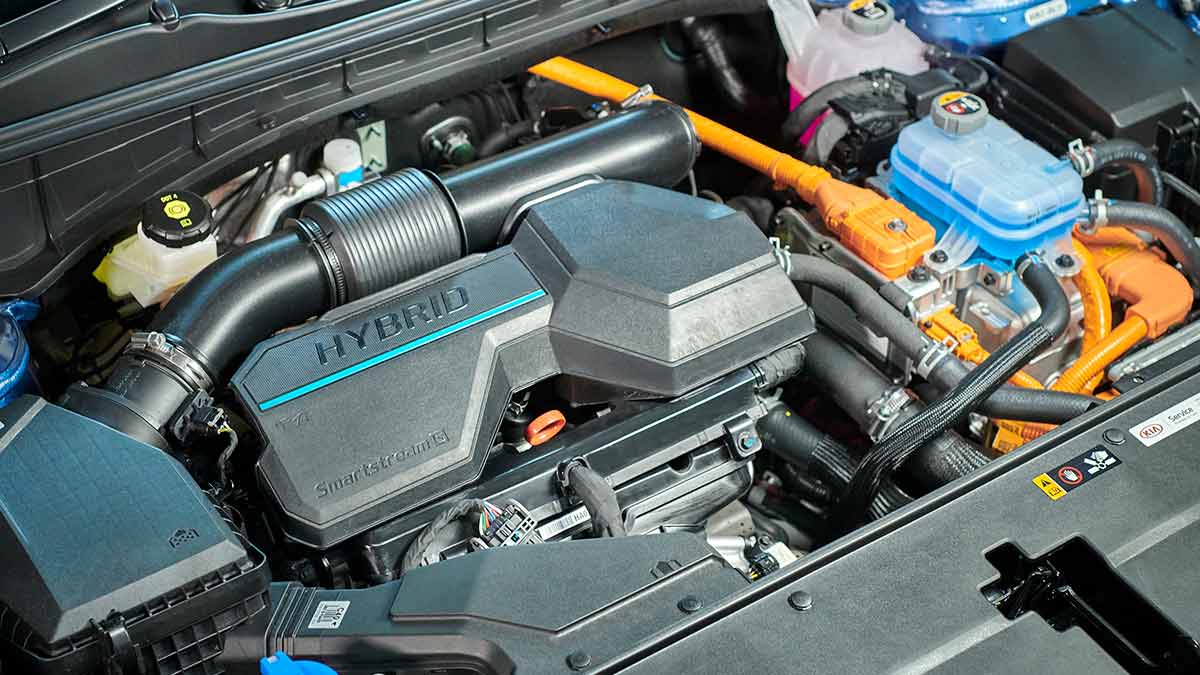The Xpeng G6 reads like a bona fide Tesla Model Y rival, but does that translate from the brochure to reality? Here we’re testing the more expensive G6 Long Range, which lives up to its name with a 570km claimed range.
2022 Kia Sorento PHEV road test review

The Kia Sorento has always been a smart seven-seat SUV. Adding a plug-in variant makes it even more appealing for those with a garage or carport.
Plug-in hybrids are a horses-for-courses type of vehicle. The very fact owners must plug them in limits their relevance to those who live in houses or have access to a wall-charger at work.
For those who do have a convenient power point, the prospect becomes more enticing, particularly when looking at big vehicles like the Kia Sorento.
Even the diesel-powered Sorento consumes 6.1 litres every 100km, while Sorento PHEV owners can manage around 50km of electric-powered range before the petrol engine kicks in, giving the car an official fuel use of 1.6 litres/100km.
On this page
- How much does the Kia Sorento PHEV cost?
- How safe is it?
- What's it like inside?
- What's under the bonnet?
- Is it efficient?
- How does it drive?
- Should I buy one?
How much does the Kia Sorento PHEV cost?
Too much, but it is probably worth it. Supply limitations forced Kia Australia to rationalise its Sorento PHEV line-up to just one specification.
It opted for the top GT-Line outfit, on the basis about half of private buyers went for the GT-Line versions of the regular diesel and petrol model.
As a result, the retail price is $80,330, meaning buyers are paying a $15,000 premium over the comparable diesel-engined version. With that impost, it is crucial potential owners do the sums to see how long it will take to get a return on the investment.
If the daily commute is less than 50km and the cost of energy is low enough, then it’s worth considering.
There is a heap of folks who think it’s worth it - demand is higher than supply, though most buyers will only have to wait around a month.
It is worth noting the running costs for the Sorento PHEV come in at $4894 over seven years or 70,000km. That’s effectively $700 a year - not cheap by any standards. Did we mention you need to plug it in?
How safe is the Sorento PHEV?
The Sorento was assessed as a five-star vehicle by ANCAP in 2020.
That rating applies to all variants, including the PHEV.
The one blight on the big SUV is the fact the side airbags don’t extend into the third row.
Adult occupant protection scored 82 per cent, largely attributable to the off-set frontal crash (where 50 per cent of the Sorento’s front area strikes an oncoming 1400kg sled that are both moving at 50km/h). In this scenario ANCAP found “protection of the driver chest and upper legs was weak and lower legs was marginal, while protection of the passenger’s upper legs was marginal” (the scoring system rates at good, adequate, marginal, poor and weak).
Child protection was deemed to be 85 per cent.
The Kia Sorento is fitted with lower isofix anchorages on the rear outboard seats in the second and third row of seats, and top tether anchorages for all rear seating positions. That works well, given most adults don’t want to be in the third row for any longer than necessary.
Vulnerable user protection was scored at 63 per cent.
ANCAP notes pedestrians stepping out in front of the Sorento PHEV will face “marginal and poor results at the base of the windscreen and on the stiff windscreen pillars. The bumper provided good or adequate protection to pedestrians’ legs, however protection of the pelvis was predominantly poor”.
The safety assist features rated a solid 89 per cent.
All sensor-based featured tested as “good” except for the middle-row centre seat, which doesn’t have an occupant detection system.
Standard software includes lane-keep assist, a 360-degree camera, rear cross-traffic alert, driver attention alert, adaptive cruise control and speed sign recognition.
What’s the Kia Sorento PHEV like inside?
As the top-spec variant, the Sorento PHEV doesn’t want for creature comforts. Default kit extends to a 10.25-inch infotainment touchscreen with inbuilt satnav, digital radio and smartphone connectivity, 12-speaker sound system, 12.3-inch digital driver’s display, wireless phone charging, dual-zone air-conditioning, heated and ventilated powered leather front seats, heated second-row outboard seats, a sunroof and in-car intercom that lets front-seat occupants talk to (and hear) those in the third row.
You can’t ask for much more in any car, let alone a people-mover.
The infotainment system can be laggy when using wireless smartphone connectivity but is otherwise reasonably intuitive and hi-resolution.
Cargo capacity is 175 litres with all seven seats in use, jumping to 604 litres if the third row is unoccupied and folded down.
What’s under the bonnet of the Kia Sorento PHEV?
The combination of a 14kWh battery and electric motor is a big boost to the big SUV. The electric charge provides a WLTP-accredited range of 57km and 67kW/304Nm of propulsion.
It is supplemented by a 1.6-litre four-cylinder turbocharged petrol engine delivering 132kW and 265Nm.
The Kia Sorento PHEV can operate in electric-only mode, or the engine can recharge the motor on the run. Alternatively, owners can switch into Sports mode, which activates both powertrains to deliver 195kW/350Nm (the formula is complicated, but as power from the electric motor drops, the petrol engine starts reaching peak figures, which is why you can’t combine the two).
Towing capacity is down from 2000kg in a conventional Sorento to a more modest 1350kg with the PHEV.
Is the Kia Sorento PHEV efficient?
If you can recharge the Kia Sorento PHEV before it runs out of electricity, then yes. The official 1.6 litrs/100km combined cycle rating reflects just how efficient the 14kWh battery is.
The WLTP cycle rates it as good for 57km ... on-the-road experience shows most owners should manage 50km based on our testing.
That's impressive for a car with a 2.1 tonne-plus mass once there's a driver on board.
Travel beyond the battery's range and the 1.6-litre turbo petrol engine is going to start chewing fuel trying to replenish the battery. At that point expect figures in the eight-litre range if you're cruising around town.
How does the Kia Sorento PHEV drive?
Despite packing a 140kg battery pack, the Sorento PHEV handles and performs much like its regular stablemates.
It weighs in at 2056kg. That’s not light but decent suspension means the Kia feels planted on the road unless you’re trying to drive it like a sports car. Don’t. Not only does it affect the drive, fuel use will rise dramatically (assuming you’ve engaged the engine and the motor).
Operated like a people-mover, the all-wheel-drive Sorento is a serene cruiser. There’s a little bit of thump over speed bumps if the rear seats aren’t occupied, otherwise it handles the cut-and-thrust of urban driving as well as any large SUV.
There’s not much evidence of body roll through the turns and noise insulation is top-notch.
The steering is direct and speed-sensitive, as well as adjusting weight (the resistance to turning the wheel) when in sports mode.
Should I buy one?
Do your homework. The upfront cost and pricey servicing means potential buyers really need to determine how they’ll operate the Kia Sorento PHEV.
Use it for daily trips up to 50km and have the capability to recharge it overnight and there’s a good chance the long-term prospects will work in your favour.
If you don’t have a power-point at your regular disposal, vehicles like the Toyota Kluger hybrid (which recharges directly off the petrol engine) will be a cheaper and potentially more viable alternative.
The information provided is general advice only. Before making any decisions please consider your own circumstances and the Product Disclosure Statement and Target Market Determinations. For copies, visit racv.com.au. As distributor, RACV Insurance Services Pty Ltd AFS Licence No. 230039 receives commission for each policy sold or renewed. Product(s) issued by Insurance Manufacturers of Australia ABN 93 004 208 084 AFS Licence No. 227678.











